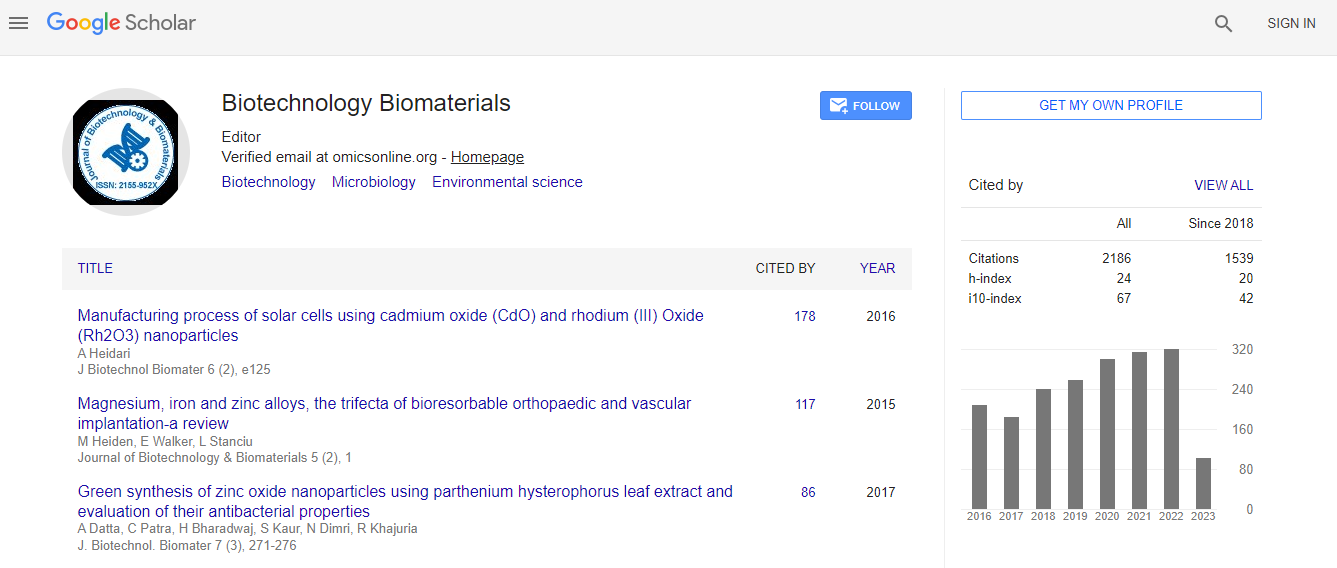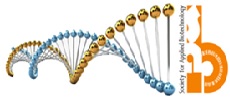Our Group organises 3000+ Global Conferenceseries Events every year across USA, Europe & Asia with support from 1000 more scientific Societies and Publishes 700+ Open Access Journals which contains over 50000 eminent personalities, reputed scientists as editorial board members.
Open Access Journals gaining more Readers and Citations
700 Journals and 15,000,000 Readers Each Journal is getting 25,000+ Readers
Google Scholar citation report
Citations : 3330
Journal of Biotechnology & Biomaterials received 3330 citations as per Google Scholar report
Indexed In
- Index Copernicus
- Google Scholar
- Sherpa Romeo
- Open J Gate
- Genamics JournalSeek
- Academic Keys
- ResearchBible
- China National Knowledge Infrastructure (CNKI)
- Access to Global Online Research in Agriculture (AGORA)
- Electronic Journals Library
- RefSeek
- Hamdard University
- EBSCO A-Z
- OCLC- WorldCat
- SWB online catalog
- Virtual Library of Biology (vifabio)
- Publons
- Geneva Foundation for Medical Education and Research
- Euro Pub
- ICMJE
Useful Links
Recommended Journals
Related Subjects
Share This Page
Protein-protein and peptide-protein interactions to elucidate protein and cell structures as well as to modulate pharmacological barriers
Biotechnology World Convention
Ingolf E Blasig
Leibniz-Institut f�¼r Molekulare Pharmakologie, Germany
ScientificTracks Abstracts: J Biotechnol Biomater
Abstract
Pharmacological barriers are formed via extracellular loops (ECLs) of tight junction (TJ) proteins, such as claudins (Cldns). Thus, Cldn petidomimetics were designed as drug enhancer of the blood-brain barrier (BBB). Cldns, transmembrane proteins, limit paracellular permeation of pharmaceuticals. The tightening is achieved by protein-protein interaction between Cldn-ECLs from opposing cells. Consequently, modification of Cldn integrity by the respective peptidomimetics is proposed to enhance drug delivery through the BBB. The Cldn1 and Cldn5 derived peptides C1C2 and C5C2 were tested for structural, binding and barrier modulating properties. C1C2 revealed a beta-sheet flanked by an alpha-helix, a structure modeled in the Cldn1-ECL1 also. C1C2 affected the TJ strand morphology and transiently increased the permeability through a cell culture model of the BBB. Redistribution of various Cldns from TJs to cytosol suggested interactions with other Cldns subtypes also. FRET measurements verified heterophilic interactions between different Cldns isoforms. Analysis in TJ-free HEK- 293 cells transfected with Cldn1, -2, -3, -4 or -5 identified Cldn1 and 5 as direct targets. Binding measurements (microscale thermophoresis) with full-length Cldns and recombinant ECLs confirmed these findings with kd-values in nanomolar range. Association studies of peptides and recombinant ECLs on live-cells further confirmed the target selectivity. Freeze-fracture electron microscopy exhibited alterations in the TJ-architecture of Cldn5 by drastic P to E face transition and altered shape of the Cldn1 TJ-network with enhanced number of parallel strands. C5C2 increased the permeability of a brain endothelial cell barrier. Transmission electron microscopy showed opening of interendothelial TJs. Binding of C5C2 to Cldn5 showed also nanomolar affinity. C5C2 administration in mice resulted in concentration and time dependent BBB opening (marker uptake into brain, magnet resonance imaging). In summary, the Cldn peptidomimetics C1C2 and C5C2 transiently enhanced the paracellular permeability of Cldn1 and Cldn5 expressing cell barriers by affecting TJ localization and structure. The findings recommend Cldn peptidomimetics as templates to elucidate molecular and cellular TJ structures and as candidates to improve drug delivery to the brain.Biography
Ingolf Blasig studied biology and biochemistry in Leipzig from 1970-74. His diploma thesis was on cancer research at the Robert-Rössle-Hospital in Berlin, his dissertation dealt with the pharmacology of myocardial infarction at the Academy of Sciences (1984). He obtained his venia legendi for investigations on myocardial dysfunction at the University of Halle in 19992. From 1993-95, he was awarded project leader at the NIH, USA. Since 1992 he has been head of the independent research group for Molecular Cell Physiology at the FMP and is teaching at the universities in Potsdam and Berlin.
Email: iblasig@fmp-berlin.de

 Spanish
Spanish  Chinese
Chinese  Russian
Russian  German
German  French
French  Japanese
Japanese  Portuguese
Portuguese  Hindi
Hindi 
